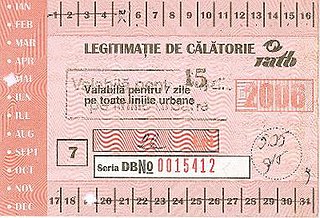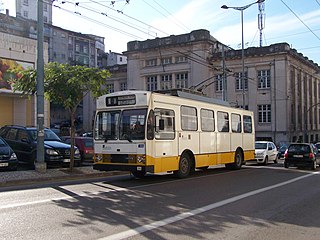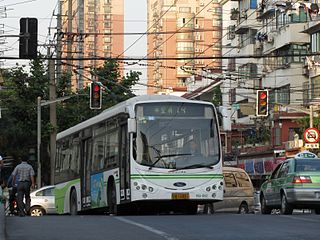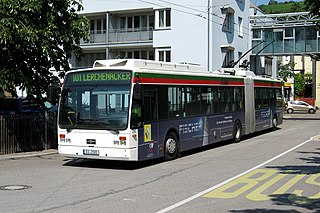
Bucharest has the largest transport network in Romania, and one of the largest in Europe. The Bucharest transport network is made up of a metro network and a surface transport network. Although there are multiple connection points, the two systems operate independently of each other, are run by different organisations (the metro is run by Metrorex and the surface transport network by Societatea de Transport București. The two companies used separate ticketing systems until 2017, when a new smartcard was introduced alongside the old tickets, which allows travels on both the STB and the Underground.

A dual-mode bus is a bus that can run independently on power from two different sources, typically electricity from overhead lines or batteries, alternated with conventional fossil fuel.

Societatea de Transport București, is the main public transit operator in Bucharest, Romania, owned by the Municipality of Bucharest.

Guided Light Transit is the name of guided bus technology and associated infrastructure designed and manufactured by Bombardier Transportation. It has been installed in two French cities: Nancy and Caen. As of 2018, only the Nancy system is in operation; the Caen system has been abandoned and will be rebuilt as a conventional tramway by 2019.
Iveco Bus is a bus manufacturer, with headquarters in Lyon, that belongs to the industrial group CNH Global through its subsidiary Iveco, based in Turin (Italy). Iveco-bus is now only a brand division of IVECO which is a company incorporated under Italian law and listed on Borsa Italiana.

Irisbus Citelis was a low-floor city bus produced by Irisbus from 2005 to 2013 when it was replaced by Iveco Urbanway.

The Yerevan trolleybus system forms part of the public transport network in Yerevan, the capital city of Armenia. Since the closure of the Gyumri trolleybus system in 2005, it has been Armenia’s only trolleybus system.

The Seattle trolleybus system forms part of the public transportation network in the city of Seattle, Washington, operated by King County Metro. Originally opened on April 28, 1940, the network consists of 15 routes, with 174 trolleybuses operating on 68 miles (109 km) of two-way overhead wires. As of spring 2016, the system carries riders on an average of 73,200 trips per weekday, comprising about 18 percent of King County Metro’s total daily ridership. At present in Seattle, a very common alternative term for trolleybus is trolley.

Škoda 24Tr Irisbus was a low-entry trolleybus model built from 2003 until 2014 by Czech trolleybus manufacturer Škoda Electric, supplying electrical equipment, in cooperation with Irisbus, supplying body.

The Coimbra trolleybus system forms part of the public transport network in the city of Coimbra, Portugal. Opened in 1947, it supplemented, and then eventually replaced, the Coimbra tramway network.

The Philadelphia trolleybus system, or trackless trolley system as it is known by its operator, forms part of the public transportation network serving Philadelphia, in the state of Pennsylvania, United States. It opened on October 14, 1923, and is now the second-longest-lived trolleybus system in the world. One of only five such systems currently operating in the U.S., it presently comprises three lines, and is operated by the Southeastern Pennsylvania Transportation Authority (SEPTA), with a fleet of 38 trolleybuses. The three surviving routes serve North and Northeast Philadelphia and connect with SEPTA's Market–Frankford rapid transit line.

The Shanghai trolleybus system is a system of trolleybuses forming part of the public transport network in the city of Shanghai, China. Of more than 300 trolleybus systems in operation worldwide, the Shanghai system is the oldest. The system turned 100 years old in November 2014 and was the first trolleybus system anywhere in the world to reach that milestone.

The Esslingen am Neckar trolleybus system serves the city of Esslingen am Neckar, in the Land of Baden-Württemberg, Germany.

The Fribourg trolleybus system forms part of the public transport network in Fribourg, capital of the canton of Fribourg, Switzerland. The system also serves the neighbouring municipalities of Villars-sur-Glâne and Givisiez, using one line in each case.
As of 2017, King County Metro operates the 10th largest fleet of buses in the United States, with a total of 1,540 buses.

The Ikarus 415T was a type of trolleybus produced by the Ikarus bus manufacturer in Hungary in 1992 and between 1997 and 2002.















